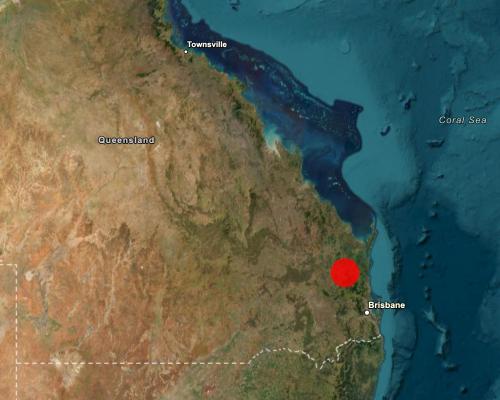
South-east Queensland has been shaken by a 5.6-magnitude earthquake.
There was no tsunami threat from the earthquake that struck on Saturday morning, the Bureau of Meteorology said.
The epicentre of the quake was at Kilkivan, west of Gympie, about 170km north-west of Brisbane, at 9.49am.
The quake struck at a depth of 10km, according to Geoscience Australia data. More than 8,000 “felt reports” have been registered, from as far away as Brisbane and the Gold Coast to the south, and Bundaberg to the north.
The former Queensland premier Steven Miles shared a Google alert of the quake on Instagram, writing: “Did you just feel the earthquake?”
Across the Sunshine Coast, Brisbane and the Gold Coast, people reported their houses shaking and a low rumble.
Sue Krucker was home in Mount Mellum on the Sunshine Coast – 100km from the epicentre – when the quake struck.
Krucker said she had lived through 13 cyclones, and was intimately familiar with the safety precautions for those, but earthquakes were highly unusual for Queensland.
“I was sitting in our home office, and the first thing I noticed was our printer activated, and then one of the pot plants started to shake.
“It was moving like a Mexican wave, from one thing to the next: the printer, the plant, my chair, my desk, my monitor. It kept progressing. Then my phone came up with an earthquake alert. It was almost a surreal moment.
“It lasted quite a while. Doors were moving. This house is a split-level Queenslander – the house was definitely moving. And when I went to stand up, my legs were shaky, I felt like I was on a rocky boat. And for sometime afterwards, I felt like my equilibrium had not been restored.”
We’ve detected an #earthquake with a preliminary magnitude of 5.6 at 9:49 AM in Kilkivan, Queensland. If you need assistance, contact your local emergency services. Complete a felt report at https://t.co/EnrrkLveAw. pic.twitter.com/i6KFTGBpEA
— Geoscience Australia (@GeoscienceAus) August 16, 2025
Krucker said her brother lived in Japan, which regularly experiences severe magnitude earthquakes.
“I’m mindful that other people go through things like this, and they are often much more extreme. This is unusual for here, but no one here is harmed, nothing’s damaged. I haven’t detected any cracks in the house. We are all safe and OK.”
Krucker said an 8.8-magnitude earthquake had struck Russia a fortnight ago, flooding rains were devastating Pakistan, while wildfires raged in southern Europe.
“An earthquake is highly unusual for here. It feels like Mother Nature is out of kilter.”
No #tsunami threat to Australia from #earthquake felt in Kilkivan, QLD (magnitude 5.6 near Near East Coast of Australia). See https://t.co/Tynv3ZQpEq. pic.twitter.com/kicTtLWE17
— Bureau of Meteorology, Australia (@BOM_au) August 16, 2025
Nearly 13,000 homes and businesses in south-east Queensland were left without power after the earthquake, Ergon Energy said. “Crews are working to return supply as soon as possible.”
Earthquakes above magnitude five occur every one to two years in Australia, with an average of 100 quakes at magnitude three or lower recorded each year, according to Geoscience Australia.
A 3.2-magnitude earthquake was recorded on Victoria’s Mornington Peninsula on Wednesday, after a 3.6-magnitude earthquake recorded west of Kingscote in South Australia on Tuesday.





